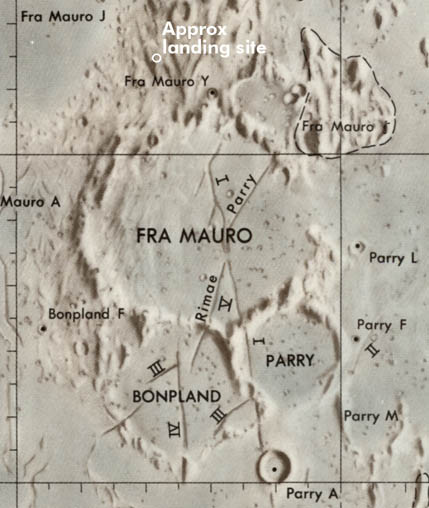Apollo 13
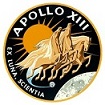
Day 4, part 3: Heading Homeward
Corrected Transcript and Commentary Copyright ©2020-2023 by W. David Woods, Johannes Kemppanen, Alexander Turhanov and Lennox J. Waugh. All rights reserved.
Last updated 2023-11-06
This is Apollo Control at 82 hours, 30 minutes. Here in Mission Control at this time we're in the process of completing a shift change. Flight Director Milton Windler and his Maroon team of flight controllers replacing Flight Director Gene Kranz and the White team. On board the spacecraft, the Flight Plan calls for the - two of the crewmen, commander Jim Lovell and Command Module Pilot Jack Swigert to begin a 5-hour rest period shortly. All three crewmen are scheduled to be eating at this time or to have finished by now. The Lunar Module has been essentially powered down, and at the present time we're showing a total current on the Lunar Module ranging between 14 and 15 or 16 amps, which is about what was expected.
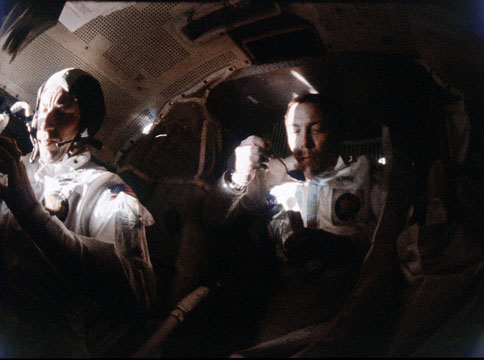
Jack Swigert and Jim Lovell eating in the LM. 16mm film capture. NASA
082:36:42 Lousma: Aquarius, Houston. [Long pause.]
082:37:07 Lousma: Aquarius, Houston. Over.
082:37:15 Swigert: Go ahead, Jack.
082:37:19 Lousma: Roger. For your information, Jack...
082:37:20 Swigert: You're loud and clear.
082:37:21 Lousma: ...all of our analysis is based on powerdown to 14 amps, but we're reading on you right now 12.3 and so we're better off than we were in our analysis.
082:37:38 Swigert: That sounds good. [Long pause.]
082:38:12 Swigert: Jack, I thought you were going to get the sleep shift where there wasn't any excitement?
082:38:18 Lousma: Well, I tried, but I didn't make it. I thought you were supposed to be sleeping now.
082:38:31 Swigert: Well, Freddo is getting something to eat, and Jim is starting to sack out so I'm taking the comm here until Fred gets set.
082:38:42 Lousma: Okay. [Long pause.]
That was Jack Swigert reporting that Jim Lovell, at the present time, is resting, and Fred Haise is getting something to eat and when Fred finishes eating Jack Swigert is scheduled to get a bit of rest.
082:39:19 Swigert: As I just - Yes, are you ready to take over? Well, he just - he just asked - said he thought I was supposed to be sleeping. And I told him that I was waiting for you to - Okay. You were off the net when they explained the - But don't they - Can't we monitor our CDU's anymore to tell when to switch antennas, so they've just - When they can see it switch - it will take a couple of minutes for them to get up. And they'll always make a voice check with you. [Long pause.]
082:40:28 Swigert: It came out here. I caught it. Okay. Now, are you getting squared away, I'll give you the comm here.
082:40:51 Swigert: Oh. No, no [Garbled].
082:40:56 Swigert: They're showing right now 12.3 amps. Their analysis is based on 14 so they're in better - Okay. Headset's yours.
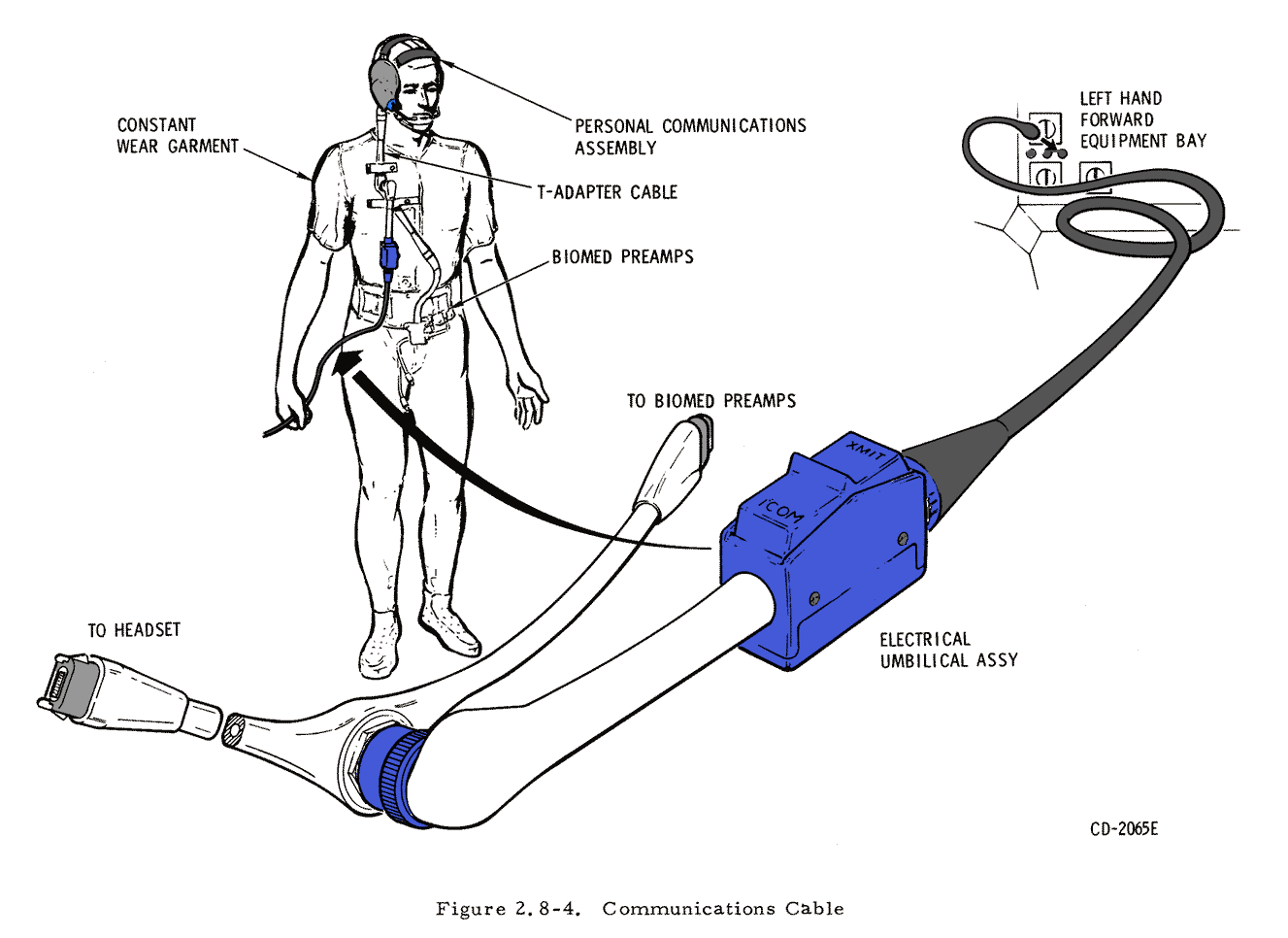
They are taking turns wearing the 'Snoopy cap' communications headset. Currently only one of them is hooked up to the LMP's audio panel. This is why the latest words we heard from the ship were one-sided with Jack's portion being captured by the mic.
082:42:12 Haise: Okay, Jack. How do you read?
082:42:17 Lousma: Hearing you loud and clear, Fred. OMNI.
082:42:22 Lousma: Okay, I heard the ...
082:42:23 Haise: I see you luck out with all the good shifts.
082:42:27 Lousma: Yes, I got all the good deals. I heard Jack brief you on the comm mode so, you got any questions about that?
082:42:40 Haise: Okay. [Long pause.]
082:43:06 Lousma: And how is your PTC going? I heard Jack tell you that we can't see your CDU's. How's it going?
082:43:17 Haise: Well, let's see, we may be offsetting slightly, the Sun looks like it may be a little higher now. Here comes the Earth by and it looks about the same perspective. I'll have to wait to see the Moon on the other side, Jack. [Garbled]
082:43:37 Lousma: Okay, Fred, I can't hear you any more on account of the background noise. I assume that - I think I heard Jack tell you what we're going to do about comm. Uplink Squelch, Off. You'll take care of the antennas because we can't see your attitude. We'll give you a voice check when come up. it'll take us 3 to 5 minutes to come up. And to make it astronaut-proof, when you see the Earth, use a forward antenna; when you see the Moon, use the aft one.
082:44:08 Haise: Yes, that's pretty straightforward. Okay, I see the Earth so I've very wisely shifted to FORWARD.
082:44:17 Lousma: Good boy. [Long pause.]
082:45:09 Haise: Got another battery?
082:45:12 Swigert: [garble] really sick.
082:45:14 Haise: Earth will be by over there in a minute.
082:47:24 Haise: And, Jack, you still up?
082:47:28 Lousma: Still here, Fred.
082:47:32 Haise: Okay, when I was upstairs, just a minute ago, I noticed what appeared to be some new ventings from down the Service Module way. I noticed that out window 1, and also saw one chunk of metal - loose metal about 4 inches square that was tumbling around - silver in color, and it looked like it had come from somewhere down in the Service Module.
082:48:04 Lousma: Okay. You saw some venting out window 1...
082:48:05 Haise: And I...
082:48:08 Lousma: Go ahead.
082:48:10 Haise: Yes, that's where I happened to be looking. The lighting was such that it showed up out there. What reminded me of it was I'm looking out the LM window now and I see a good part of the new star field it's created for us. There are about a thousand little sparklies out here.
082:48:30 Lousma: Okay, so you're seeing some venting out window 1, and you saw a 4-inch-square piece of loose metal which was silver, and - Are you still seeing the venting or has it zeroed out now?
082:48:48 Haise: I don't know. I left upstairs, I'm down in the LM now, Jack. I guess when Jack goes up he can take a look and let me know. Okay, I'll think about switching aft here directly. I see the Moon, and the Moon looks pretty good, Jack, so I guess our PTC still going pretty good.
082:49:09 Lousma: Okay, and we won't have any comm delay if the PTC stays good. [Long pause.]
082:49:32 Haise: Yes, sure enough the Moon is getting smaller.
082:49:37 Lousma: Good, and we want to ask you another question about the venting. Is this - would you suppose - some new venting or is this venting that you just hadn't - that's been going on all the time, but which you hadn't looked at recently?
082:49:56 Haise: I can't really say, Jack, we've been so tied up, down in the LM, I guess we kind of forgot about the other half. But I've been upstairs several times and hadn't particularly noticed any flow by the windows before, so I - my first assumption was that it was some new venting. It really wasn't very heavy.
082:50:23 Lousma: Okay. Copy. Thank you.
082:50:25 Haise: And Jack's going up to take a look now.
082:50:27 Lousma: Okay. And for your information, all of our numbers are based on amperage usage of 14 amps. And we're using only 12.3, so we're a little fat on our analysis.
082:50:49 Haise: Very good. Way to be.
082:50:52 Lousma: And we're in a ...
082:50:53 Haise: I'll tell you, this Aquarius has really been a winner.
082:51:01 Lousma: Well, that's one of several. And we want to tell you something that I told Jim earlier, and that concerns control. Right now you have control in hardover if you need it, but when we go to some normal control modes, since we have the quad heaters off. We want to have a 15-minute notice for attitude control request. Over.
082:51:35 Haise: Okay, Jack. Offhand, I can't imagine that since we got the platform powered down why we'd need to worry about the instantaneous control. But at any rate, we need 15-minutes warmup with the heaters before we can start using thrusters.
082:51:54 Lousma: Right. And another thing we've done is to pull your ECS and EPC DISPLAY breakers and so - But we left your CAUTION and WARNING powered up. So if you get ECS-type or EPS CAUTION and WARNING you'll have to power up those meters with the DISPLAY breakers. And we are watching for you your PIPA temperatures, your ASA TEMP, your propellant temperatures except for the DPS propellant, and we're watching your quad temps for you.
082:52:31 Haise: Okay. That's very good, Jack. You're watching them. That's good enough.
082:52:41 Lousma: And everybody's fine at home El Lago. [Pause.]
082:52:50 Haise: Great. [Long pause.]
082:53:51 Lousma: And, Fred, your CO
2 is building up. It's at 11.3 on our gauge, and we've got a medical buildup to 15 millimeters, at which time we'll switch over to secondary. Looks like we've got plenty of lithium hydroxide, about 192 hours including the CSM cartridges. And as you know, we've got a way to use those. And as soon as we get them written in some good words, why, we'll pass; that along. You might be able to make one.
082:54:13 Haise: Okay. Yes, we'll sure give her a try. And I'm showing onboard about 12-1/2 millimeters of mercury.
082:54:24 Lousma: Roger. And I have a Flight Plan update when you get a time to copy it sometime, I'll pass it along. There's no hurry on it.
082:54:35 Haise: Okay. Stand by 1. Jack's back now. [Long pause.]
082:54:48 Haise: Okay. Jack just came back and he said it's still coming out; it's coming out only on the commander's side. So he saw it out the same window I did, window 1. And it's between the minus Y and minus Z axis.
082:55:07 Lousma: Okay. And of course ...
082:55:08 Haise: Jack says it's definitely the Service Module which was - which was my impression, too.
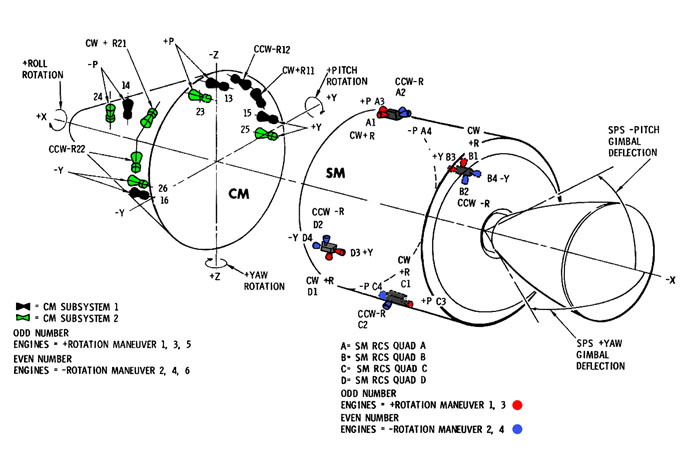
Window 1 is on the left side of the spacecraft. Looking backwards from it, the area Fred specifies is somewhere along what to him looks like the 'top' side of the SM.
082:55:14 Lousma: Okay. So you're sure it's the Service Module, and, of course, the thing we're interested in knowing, is it something that is residual from before, or is it something new. And if you have any ideas about that, why we'd sure like to have them. [Pause.]
082:55:41 Haise: Yes. Yes, Jack, I'll answer him your question in a minute, but make Jack's first impression here, is that it's not near the intensity that it was right after our mishap. And I'll have to agree with that. I'd say - he said it was a half and I said it was maybe down to a third. And Houston would like to know if you have any impressions as to whether it is still a residual from that or maybe something new. [Long pause.]
082:56:25 Haise: I don't know why after I felt that. Yes, I felt it was some new something - new venting, too. [Long pause.]
082:57:06 Haise: Okay. Switch to Forward Omni.
082:57:11 Lousma: Freddo, if you think it's practical, we're ready to give you some - we're working on some camera settings for pictures of the venting. And, if you have a camera out and ready to go, let us know which one it is so we can get the settings for that camera. What do you think about that.
082:57:30 Haise: Okay. Jack's got the one with the 250-millimeters lens on it. That's the standard EL. And I have a surface camera out that I've been shooting hundreds of Earth/Moon pictures with, camera 1. And we also have the Reseau upstairs that's pretty handy. The Command Module DC camera. So you can about ...
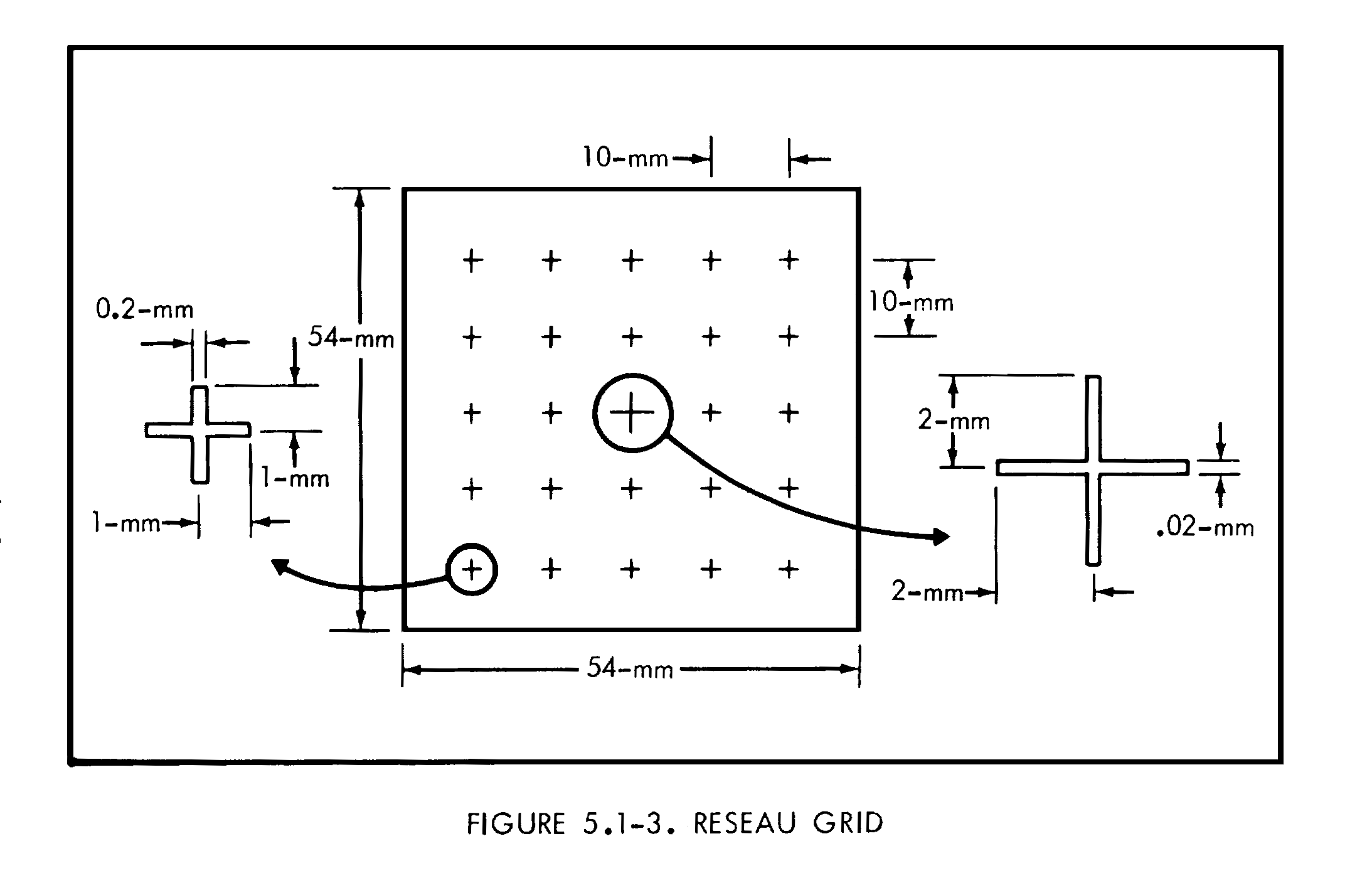
Diagram of the Reseau grid, as installed on the camera.
082:58:00 Lousma: Okay. I copy that...
082:58:01 Haise: ...take your choice, because...
082:58:04 Lousma: I copy the 250 millimeter, the Reseau is available, but I didn't get what other one is.
082:58:14 Haise: Okay. I got my Hasselblad surface camera down in the LM here handy, too, camera 1.
083:00:04 Haise: And, Jack, if we're going to do any picture taking out the Command Module windows, I think we'd better do that pretty quick, or hold up until Jim and Jack get their rest done.
083:00:21 Lousma: We concur with that. [Long pause.]
083:01:23 Lousma: Okay, Fred, we're not going to bother the skipper up there. We won't be taking any pictures out of the Command Module window until after rest period.
This is Apollo Control at 83 hours 2 minutes. Fred Haise has the watch at the present time in the Lunar Module, while Jim Lovell and Jack Swigert attempt to get some rest in the Command Module. The Flight Plan calls for a five hour rest period for both the commander and the Command Module Pilot. A recapping briefly - Fred Haise remarks after coming back to the LM from the Command Module where he had been getting something to eat. Fred reported that he had observed some venting apparently from the Service Module and had also seen a four inch square piece of metal which he described as silver in color float by the window of the Command Module. He was looking out the number one window, which is viewed from inside the Command Module - is the window to the left of the commander's couch, the far left window. Haise was asked if he felt the venting was something new or if it was residual venting from the original event which had caused the loss of power and oxygen to the Service Module. He did not know and we also have not determined here on the ground whether this was an event associated with the original loss of power from the Service Module or whether it is something new. That's being evaluated at this time. Haise said he did feel definitely that the event was coming from the Service Module - that the piece of metal he had seen floating by was from the Service Module and that the venting was from the Service Module. Flight director Milton Windler, after reviewing the situation, elected to wait until after the commander, Jim Lovell, and the Command Module Pilot Jack Swigert had completed their rest period before attempting to get back into the Command Module and photograph the venting and whatever pieces might be visible out the window.
This is Apollo Control at 83 hours 11 minutes. A change of shift press briefing is being planned to being in about 10 minutes at 12:35 AM in the main auditorium at the Houston New Center. The participants in the press conference will be flight director Gene Kranz and astronaut Tony England. And repeating the time for that change of shift briefing is tentatively planned for 12:35 AM - about ten minutes from now.
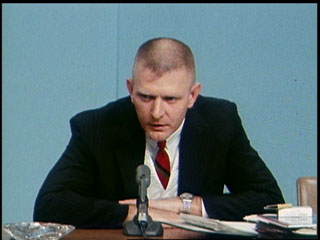
Gene Kranz at the midnight conference after the PC+2 burn. NASA 16mm film capture. NARA.

Astronaut Tony England talks to the press about the canister adapter prototype. NASA 16mm film capture. NARA.
083:10:59 Haise: Shifting to Forward Omni. [Long pause.]
083:11:44 Lousma: Okay. Fred, for your information, your CO
2 reading onboard is a little higher than what we're reading here on the ground, and so when it gets to 15 on your meter, switch to secondary. And we'd like to get a status about every 30 minutes - we'll give you a call on that. But just to let us know we're still thinking about you, we'd like you to go Biomed Right, please.
083:12:14 Haise: Okay. Going Biomed Right.
083:13:57 Haise: How, how do you read me on this comm mode on S-band?
083:14:03 Lousma: 5 square, Fred. How me?
083:28:03 Lousma: We're still here, Fred. How's it going?
083:28:11 Haise: Okay. My CO
2 reading is now just below 13.
083:28:21 Lousma: Say again what it is.
083:28:25 Haise: It's just - just below 13.
083:28:29 Lousma: Okay. Just below 13. And just for your information, we've got people working on several subjects. We're working on the midcourse coming up to determine our control system and how to do it with the control system we select, what we should do about the alignment. We've got the LMS and a couple of crews cranked up working on that. And we're also working on our entry, how and when we ought to activate the CSM. And we're working on the CSM systems status. Tomorrow sometime we're going to have a Main Bus B checkout, so we've got a lot of people swinging pretty hard here and I've got some f-stop settings for you for the lunar surface camera. At 1/250th, we'd like you to take targets of opportunity. Each picture use three f-stops, because we don't know exactly which one is going to work the best, so use 4, 5.6, and 8 and 1/250th for the surface camera. Copy? [Pause.]
083:29:52 Haise: Okay. Use the surface camera at 1/250th, 4, 5.6, and 8. And I've been doing quite a bit of shooting at covering two of those numbers in the range 5.6, and 8. I've also been shooting some at 11, so I'll just drop it down a little more. The Moon is still so big and bright there that I got a feeling that the Moon is probably up around the f/8 to f/11 range.
083:30:26 Lousma: Roger, I didn't catch that last part. Maybe when the comm gets a little better you can say it again. [Pause.]
083:30:43 Haise: Okay. How do you read now, Jack?
083:30:45 Lousma: That's a lot better, Fred.
083:30:48 Haise: Okay, I just said the Moon is still so bright, that I think probably the higher range of f-stops will be better; f/8, maybe even f/11.
083:31:02 Lousma: Okay. [Pause.]
083:31:11 Haise: I can just barely, on the left corner of the Moon now, make out the foothills of Fra Mauro formation. We never did get to see it when we were in close, there. [Pause.]
083:31:33 Lousma: Okay. I'm reading on my monitor here, Fred, that you're 16,214 miles away from the Moon moving at about 4,500 feet per second. [Pause.]
083:31:56 Haise: Okay. [Long pause.]
083:32:21 Haise: From the sounds of all the work that is going on and is still going on, this flight is probably a lot bigger test for the system on the ground than up here.
083:32:41 Lousma: Yes, you've been - you've been working it out a little bit. [Pause.]
083:32:55 Haise: Yes. I've really got a tough job right now switching Omnis. [Pause.]
083:33:08 Lousma: Well, everybody down here is 100-per-cent optimistic. Looks like we're on the up side of the whole thing now. [Pause.]
083:33:21 Haise: Yes, I guess we had better be in good shape, particularly ourselves, rested for that entry day. I think that is going to be a pretty busy one.
083:33:33 Lousma: Right, and we're working on procedures for that. Ken's been doing quite a bit of work on getting ready for entry.
083:33:47 Haise: Very good.
083:47:12 Lousma: How's it going Fred?
083:47:18 Haise: Okay. Just fine.
083:47:20 Lousma: Okay. We're considering a midcourse correction at 104 hours - about 20 hours from now - 18 hours from now, and it's only 7 feet per second. The other option is to keep PTC up, since we may not be able to get back into it again, and delay it. So, that's the type of thing we're thinking about, but - just wanted to let you know that you're pretty much right in the middle of the fairway there and our present tracking, with no midcourse has you - with a Gamma of 7.11, as opposed to 6.51. So, you're already in the corridor. You're just a half a degree between the center and the outer limits and we're going to tweak that up.
083:48:15 Haise: Okay. That sounds good.
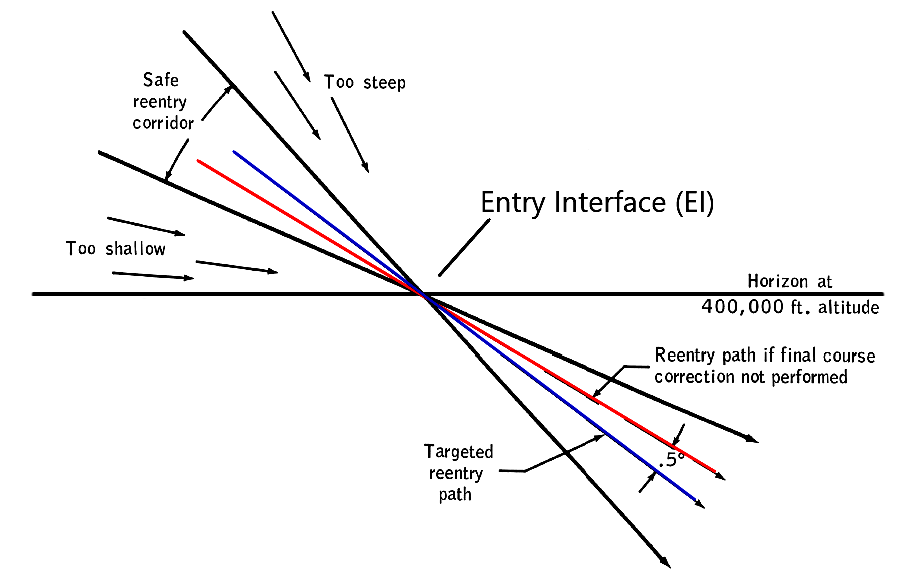
The predicted re-entry corridor.
083:48:20 Lousma: And - we don't - Well, we think there might have been a misunderstanding earlier on the potable water. Don't worry about drinking water. Drink all you want. There's plenty of it. There's 38 pounds, and the Surgeon recommends that you use some of the fruit juices as well. Over.
083:48:43 Haise: Okay. Yes, we went up and - and used the procedure to pressurize surge tank, and Jack and I made up a total of 22 drinks of - drinking water.
083:49:02 Lousma: Okay. [Long pause.]
083:49:19 Lousma: And I assume that Jack is up there sleeping now too, right?
083:49:26 Haise: Yes. That's affirm. They're both up there. [Pause.]
083:49:40 Haise: I hate to say it, Jack, but I think our PTC is about to wobble off a little bit. I've noticed that the Earth is coming by somewhat lower in the window and the Moon is going by somewhat higher.
083:49:59 Lousma: Okay. Understand. PTC, Earth is coming by lower and Moon is coming by higher.
083:51:58 Lousma: And, Fred, on this jerry-rigged Command Module lithium hydroxide canister, what we're going to do is we're going to have to make at least two up and use two at a time - one on each set of hoses. What we'll do is we'll connect one of these jerry-rigged boxes to the red fittings and air will be sucked through the lithium hydroxide and then blown out the blue fitting. And we're also going to, when we do this, remove the LM lithium hydroxide canister from the suit loop, either the primary or the secondary, and we're getting the words together to make it easy to build one of these things, and it looks like it will probably take two guys, so, I think we probably ought to plan to do that later. In addition, we have to go up and get a couple of canisters out of the Command Module, so it looks like maybe a smart idea would be to delay a little bit and have you build a couple of these later on. What do you think?
083:53:17 Haise: Yes. I agree Jack. Jack Swigert and I went upstairs earlier and both got a canister, and we were scratching around for some material and thinking about using them, and that's actually why - when we made up all the water to drink because we needed the plastic container that they were housed in in the pantry, and we had that ready to use with some material plus some of the - the extra porous bags that were going to be used for the dump control that we may just cut up and use, too.
083:53:54 Lousma: Did you come up with a design or ...
083:53:56 Haise: Plus we got lots...
083:54:00 Haise: No. We just thought we'd see what we had in the way of material and stand by for your word. Of course, we also have lots of stiff-backed cardboard flight data.
083:54:15 Lousma: Yes. We have decided to use a canister and, you know that the liquid-cooled garment has a bag around it that we think we can use, too, or that we know we can use. We've tried it. So what you have is the - a bag within a bag and inside that is the liquid-cooled garment. The bag that is closest to the liquid-cooled garment is the one we need, and we've got two of them. And then, of course, we've got to use some tape and, as you say, one of the backs to flight data file time line book or something like that, and, just using those materials, we can make this jerry-rigged canister. So, the bag that we're looking for is the one that is right next to the liquid cooled garment, and, if we're very careful about where we cut it, we can make a pretty good rig.
083:55:31 Lousma: It looks like we'll have to use that bag over again, though, because we only got two of them, and I expect that we'll have to make more than two of these canisters up.
083:55:44 Haise: Roger. [Long pause.]
083:56:35 Lousma: Fred, in about 4 minutes, we're going to hand you over to a different communications site, and it's going to take us about a minute or so to reestablish uplink, so you can be prepared for that.
083:56:51 Haise: Okay, Jack.
084:00:40 Lousma: Freddo, we've handed over now. How do you read?
084:00:46 Haise: Loud and clear, Jack.
084:00:48 Lousma: Same here.
084:00:56 Haise: In fact, you're coming in a little louder.
084:01:03 Lousma: Fred, you'll have to say again. Can't read you there. There's too much background noise. Maybe we need a new antenna.
084:01:14 Haise: Okay. I'm on the other OMNI now. I just said that you're coming in even louder than previously.
084:01:24 Lousma: Roger. Maybe it's because I'm standing up. You're coming in better now, too.
084:04:46 Haise: And, for your information, Jack, I'm just going to tear into some beef and gravy and other assorted goodies.
084:05:01 Lousma: I presume that you're doing this with the full permission and - of the commander. [Pause.]
084:05:19 Haise: And this - at this moment, who do you think is the commander? [Pause.]
084:05:31 Lousma: If I was him, I'd make you sign out everything you ate, so I'd know. [Long pause.]
084:05:56 Haise: Well, I'm sneaking inside of the LM where he doesn't have [garble] Incidentally, this PTC must have some - must have a wobble mode around our X-axis there because now the Moon and Earth are back in the right perspective.
084:06:18 Lousma: Good. Let's see if it goes the other way. [Long pause.]
084:06:40 Lousma: These guys down here are saying they knew it all the time. [Long pause.]
084:06:56 Haise: Well, that's right. They do good work. Whoever heard of doing a P52 in the LM?
This is Apollo Control at 84 hours 8 minutes. During the change of shift briefing, CAPCOM Jack Lousma kept up a fairly constant stream of communication with Fred Haise who is on-duty ...
... who is on duty in the Command Module in the Lunar Module rather. I would like to recap for you some of the things that were discussed during that period of time. Lousma advised Haise that the mid-course correction being considered at this time is a 7 foot per second maneuver which would occur at 104 hours. The other option which ...
084:08:48 Lousma: Say, Fred, sometime when you're not too busy chewing on that beef, how about telling us what the CO
2 reads? [Pause.]
084:09:03 Haise: Okay, I'm reading 13, 1 3.
084:09:07 Lousma: Okay. It looks like our reading is getting kind of close to yours.
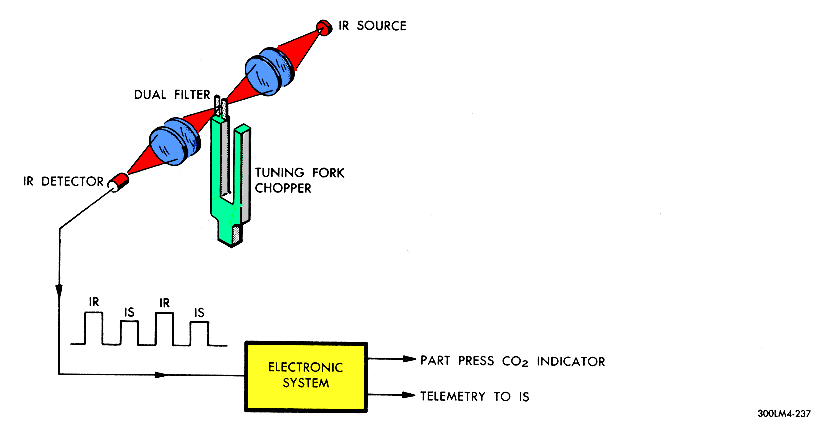
Layout of the carbon dioxide sensor in the Lunar Module.
Lousma discussed with Fred Haise the options that we have on that mid-course correction at 104 hours. The other option being to delay the mid-course correction. If that were done, it would not be necessary to stop the passive thermal control mode which the Lunar Module is in at this time. That is being considered but no decision has been made. The carbon dioxide levels in the Lunar Module were also discussed and a procedure was passed up to Haise for keeping tabs on the rising CO2 level, and for changing to the backup lithium hydroxide canister when the level reaches 15 millimeters of mercury - partial pressure. The surgeon also recommended that the onboard reading be used for this indication. It was felt that the onboard reading would be somewhat more accurate although we've been reading about the same thing on the ground as Haise has been reporting from the spacecraft, and at last report the level of CO2 was at about 13. At one point Haise reported that the passive thermal control appeared to be degrading a bit. Said that everytime the spacecraft rotated one complete revolution, the Earth would appear to be a bit lower in the window, and the Moon appeared to be moving higher in the window. I believe you heard Haise report later that there may have been some sort of a wobble in the passive thermal control and that the Earth and Moon were now back in the proper position in the windows. So that's another area that we'll continue to watch, and see how the passive thermal control mode maintains itself. We've also had a communications hand-over. Handing over from the tracking site at Goldstone, California to the tracking site at Honeysuckle Creek, Australia.
084:14:39 Haise: Yes. It appears the wobble is going the other way, Jack, because the Earth is now rising and the Moon is starting to get lower in the window.
084:14:52 Lousma: Roger. Could you give us an LPD number periodically?
084:15:02 Haise: LPD number? Yes, okay.
084:15:09 Lousma: In fact, if you could give it two or three REVs in a row, why then we could predict where it's going and maybe help us set it up again if we have to.
084:15:22 Haise: Okay. [Long pause.]
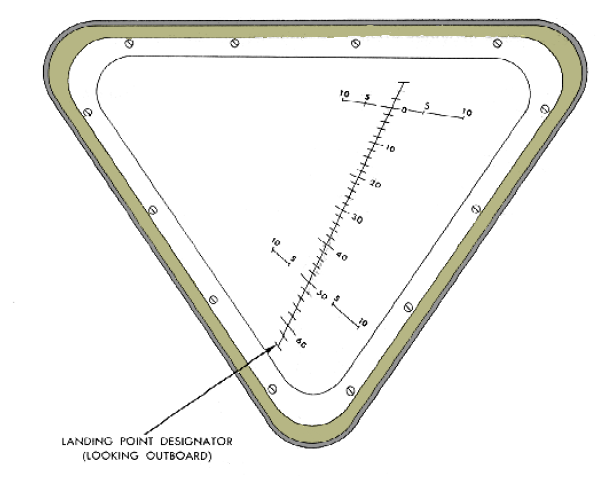
The LM window.
084:15:36 Haise: Okay. The center of the Earth has just gone by at an LPD number of 4.
084:15:42 Lousma: Roger. LPD 4, center of the Earth.
084:20:59 Haise: And the center of the Moon is about LPD 21.
084:21:04 Lousma: Okay. LPD 21. Is that the center of the Moon, you say?
084:21:11 Haise: That's affirm.
084:22:52 Lousma: And, Fred, we're doing a little better on our water than we had anticipated. Our numbers were designed for 3.5 pounds per hour; we're using about 3.0, and expect to go a little bit less.
084:23:11 Haise: Beautiful. [Long pause.]
084:23:32 Haise: When this flight's all over, we'll really be able to figure out what a LM can do. [Long pause.]
084:24:02 Lousma: Maybe it'll make the some more.
084:24:09 Haise: If it had a heat shield, I'd say bring it home.
084:27:18 Haise: Okay. The Earth went - just went by about - clear above the LPD index. It was - it was, if it were extended, the number would be minus 6.
084:27:34 Lousma: Okay. Way up there at minus 6.
084:27:41 Haise: Yes, there's actually no such number. I just extended the line beyond zero which, for a negative rate, is what it would be if there was one.
084:27:53 Lousma: Right. Understand. If minus 6 was there, that's where it would be. Right?
084:28:02 Haise: That's right. [Pause.]
084:28:13 Lousma: Do you still have that super-dense star field? [Pause.]
084:28:25 Haise: It's still there. I'm looking at it right now. I can look at - the Sun is right behind me, then all these sparklies show up. Yes. It kind of looks like I'm right in the middle of the - of the Milky Way. There are several thousand little sparklies at various ranges out as far as I can see [Garbled]. [Long pause.]
084:29:18 Haise: They're kind of interesting. They're all moving [garble] and sparkling there. And I can [garble] - at least I think I can what will occasionally give you a real star from the bunch of sparklies, but it really does break up the capability to pick out a star pattern, particularly through [Garbled].
084:29:52 Lousma: Okay. So far, we haven't identified what the sparklies are and what is venting. [Pause.]
084:30:12 Haise: Yes, I got a [garble] feeling that we probably won't get any [garble] until we power up.
084:34:08 Lousma: How you feeling, Fred? [Pause.]
084:34:16 Haise: Oh, as soon as I chug down this grape drink and grapefruit - orange drink, I think I'll be in pretty good shape. [Long pause.]
084:34:38 Lousma: How much sleep did you get between the burn and the time you got up for this exercise?
084:34:50 Haise: Oh, I'd guesstimate about 4 hours, Jack. Wait a minute, which burn you talking about?
084:35:03 Lousma: It was the burn we just made. Did you get any sleep between it, and the time you got up for this watch?
084:35:12 Haise: Oh, no. I didn't - I haven't been to bed since all the action the night before, and I went to go to bed for about 4 hours then [Garbled].
084:35:22 Lousma: Yes. [Long pause.]
084:35:38 Lousma: Well, we're just trying to figure out who's likely to be the most tired up there. You or Jim. [Pause.]
084:35:55 Haise: I think we'll get caught up pretty good in the next couple of days.
084:36:00 Lousma: Say again.
084:36:04 Haise: We ought to get caught up pretty good in the next couple of days.
084:38:56 Haise: Okay, Jack. The Earth has started back down. The hack on the LPD there was 1 degree.
084:39:06 Lousma: Okay. One degree on the center of the Earth.
084:42:13 Lousma: That was a good TV show you put on the other night, Fred, during LM entry. [Pause.]
084:42:26 Haise: Yes. It would have been an even better one about 10 minutes later. [Long pause.]
084:42:50 Lousma: Yes. Things sure turned to worms there in a hurry after that show. [Long pause.]
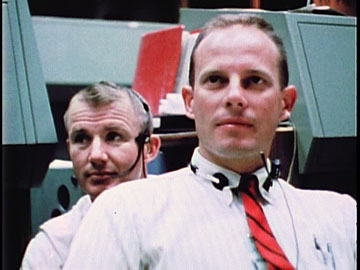
Jack Lousma and Vance Brand watching the LM TV show in Mission Control. NASA 16mm film. NARA
084:43:12 Haise: Yes. You're right. [Long pause.]
084:43:28 Haise: Okay. The center of the Moon now is about minus 2 degrees DELTA-V.
084:43:35 Lousma: Minus 2 degrees, center of the Moon.
This is Apollo Control at 84 hours 44 minutes. The numbers that Fred Haise just read back down from the spacecraft refer to the position of the Moon, with respect to the landing point designator on the LM window. Haise reported earlier that the passive thermal control mode possibly was degrading a bit. He said that every time the spacecraft rotated, the Earth would appear to be a bit higher in the window and the Moon a bit lower. A short while after that he said that it may have corrected itself. That the Earth and the Moon appeared to be in about the right place. Mission Control asked him to try and give us the degree readings on the landing point designator for a couple of revolutions as the Earth and Moon rotated by and we'd keep a little closer watch on it and see if there was any significant change.
084:44:44 Lousma: Charlie said to say hello. [Pause.]
084:44:51 Haise: Who's that?
084:44:53 Lousma: Charlie.
084:44:58 Haise: Is he still around there? [Long pause.]
084:45:16 Haise: Unless my watch is wrong, it says it's almost 2 a.m. back there.
084:45:22 Lousma: No. That's the bearded one. [Pause.]
084:45:29 Haise: Oh! Okay. [Long pause.]
084:46:15 Haise: Hey, tell Charlie that I'll be back down there personally to thank him for this baby.
084:46:28 Lousma: Sure will. I did.
This is Apollo Control at 84 hours and 48 minutes. The Charlie who was referred to a few minutes ago in the conversation between Jack Lousma and Fred Haise was not Astronaut Charles Duke, but rather one Charlie Mars who looks after the Lunar Modules at Cape Kennedy prior to launch. At this time the Flight Plan that we have on one of our display boards here in Mission Control shows that Commander Jim Lovell and Command Module Pilot Jack Swigert have a little bit more than 3 hours remaining in their sleep period. The Flight Plan is relatively open. Also from 87 hours to 88 hours, which would indicate that there might be a better flexibility in extending that sleep period.
084:50:21 Haise: Okay. The Earth went by there, Jack, at LPD about 18 degrees.
084:50:28 Lousma: Roger. We copy 18 degrees for the center of the Earth.
084:53:56 Haise: Okay. The Moon - I'd estimate it up around minus - somewhere 17 to minus 20 degrees LPD.
084:54:07 Lousma: Okay. Moon's minus 17 to minus 20.
084:55:14 Lousma: How would you like to spend a week on an aircraft carrier getting back? [Pause.]
084:55:28 Haise: If I can get on an aircraft carrier, I don't care how long it takes, Jack. [Long pause.]
084:56:28 Lousma: They're going to take you by helo to Samoa. You'll spend the night in Samoa, get on a 141, and be at Ellington shortly thereafter. [Pause.]
084:56:46 Haise: Okay. Kind of sounds like the original plans for the [garble] [Long pause.]
084:57:24 Lousma: Had you worrying that you're going to spend the night on the ship, helo to Samoa and directly to Ellington.
084:57:35 Haise: Very good. [Long pause.]
084:58:27 Haise: Boy, these thrusters are sure [Garbled]
084:58:35 Lousma: Fred, I'm not reading you. Maybe we'd better wait until we change antennas or unless you can speak up a little louder.
084:58:43 Haise: How do you read now?
084:58:45 Lousma: Better.
084:58:49 Haise: Okay. The thrusters [garble] and the [garble] outside [garble] and they hardly look like they [Garbled]
084:59:12 Lousma: Gee, I'm sorry, Fred. We're just not reading you right now. Maybe we'll have to wait a little bit.
084:59:20 Haise: Okay. [Pause.]
084:59:29 Lousma: Let's try it now. If you can speak up, the background noise has gone down a little bit.
084:59:37 Haise: Okay. How do you read now?
084:59:39 Lousma: A little better.
084:59:44 Haise: I was just commenting - I've been looking here at the thrusters on quads 1 and 4. We've got a slight discoloration on the outside of the barrel. The nozzles look like they hadn't ever been fired, - like they're brand new. [garble] of like those skinny things on the interior on the upper nozzle [garble] [Pause.]
085:00:14 Lousma: You say the coloration of the thrusters appears they haven't been fired on quads 1 and 4?
085:00:24 Haise: I'm saying all of them look clean again. I guess they've fired so clean that they don't seem to [garble] at all. [garble] different color, [garble] copper, bronze, color of the oxygen cell. They've been fired because I watched them fire. Okay. The Earth's going by at an LPD of 42.
085:00:58 Lousma: Roger. Copy LPD 42. Is that affirm?
085:01:03 Haise: That's affirm. [Long pause.]
085:01:17 Lousma: And, Fred, that may be why the comm is a little bit degraded, more background noise, because we're getting out of attitude a little bit there.
085:03:38 Haise: How do you read on AFT Omni now [Garbled]?
085:03:43 Lousma: I'm reading you, Fred. I've got a lot of background noise. Looks like it might come and go with attitude.
085:03:54 Haise: Yes. I think that's probably - just looking through the Command Module at you now. [Long pause.]
085:04:45 Haise: How do you read now, Jack?
085:04:47 Lousma: About the same, Fred.
085:04:52 Haise: Okay. [Long pause.]
085:05:08 Haise: Okay. And the Moon just went by at about minus 14 degrees.
085:05:13 Lousma: Okay, the Moon at minus 14. [Pause.]
085:05:24 Haise: That - that's correct.
085:05:28 Lousma: Okay. Your landing in - your weather in the landing area, which is about 560 miles south of Samoa, is now predicted to be about 1500, scattered, high broken. Waves are going to be 5 feet, the winds are going to be 15 knots, visibility 10 miles, showers in less than 10 percent of the area, and you will be landing at 08:00 local, roughly.
085:06:04 Haise: Hey, that all sounds pretty good.
085:08:29 Lousma: Say, Fred, did you get the dope on the Saturn IV impact - S-IVB impact?
085:08:41 Haise: Yes. Just as we came around the corner, Vance told us that it hit - I don't recall the position now, but it was a [garble] impact [garble] and recorded it on the [garble] seismometer. [Pause.]
085:09:04 Lousma: Yes. It impacted 74 nautical miles from the ALSEP and the passive seismic detected major seismic activity on all long period channels and this was - this activity was detected for 4 hours afterwards with decreasing amplitude. And the impact also was detected by the high-energy channels [garble] The high-energy channels of the SIDE. [Long pause.]
085:09:58 Haise: Yes. That ought to add [garble].

AS12-47-6918 - Apollo 12 photograph showing the Passive Seismic Experiment deployed on the lunar surface by Pete Conrad and Alan Bean. This is the instrument that is now providing NASA with data on the interior of the Moon, thanks to the impact of the S-IVB. LPI/USRA
This Apollo Control at 85 hours, 11 minutes. CapCom, Jack Lousma, has been keeping up a fairly steady stream of conversation with Fred Haise who has the watch aboard the Lunar Module. Commander Jim Lovell and Command Module Pilot Jack Swigert have been in a scheduled five hour rest period since a little after 82 hours ground elapse time - just about 3 hours now. At the present time Apollo 13 is about 20,400 nautical miles from the Moon, traveling at a speed of 4,396 feet per second.
085:11:42 Haise: Okay. The Earth LPD number that time was 32.
085:11:48 Lousma: Roger. Thirty-two.
085:14:57 Haise: How do you read now, Jack?
085:15:02 Lousma: I'm reading you, Fred. I've got a lot of background noise, though.
085:15:08 Haise: Jack, I can definitely tell we're moving away from the Moon, now. I got it all in the monocular at one time. We're right over the top of Messier A right now.
085:15:23 Lousma: You're right over the top of what?
085:15:24 Haise: On a point between it and Censorinus - Messier A and - the point halfway between there and Censorinus. [Pause.]
085:15:46 Lousma: Freddo, would say the checkpoint over which you're right now?
085:15:56 Haise: Okay. And incidentally, the LPD on the Moon was zero, so it's coming back down. The point looks like we're just about straight over is around Censorinus and the point between it and Messier A.
085:22:07 Haise: Okay. And, Jack, the Earth LPD angle is 24 degrees.
085:22:14 Lousma: Roger. Earth at 24. And it looks like you're getting up to about 15 on the CO
2, so we want you to select Secondary and swap out the primary cartridge. Over.
085:22:30 Haise: Okay. I'll select Secondary and swap out the primary cartridge. [Long pause.]
085:22:53 Lousma: Okay, Fred. And when you select - When you swap out the primary cartridge, don't reselect Primary. Stay on Secondary until we use the secondary up. Over.
085:23:10 Haise: Okay. I'm changing out primary and - stay in Secondary until we use it up.
This is Apollo Control at 85 hours 26 minutes. In Mission Control our displays were very quick to show the effects of the change over from the primary lithium hydroxide canister to the fresh backup canister. The partial pressure of carbon dioxide which had been reading 14.9 millimeters of mercury has dropped to 4.6 at the present time and is continuing to go down from there.
085:29:43 Haise: And the change out is complete, Jack.
085:29:50 Lousma: Okay. Copy the changeout complete, and we're reading 4.5 on the CO
2 here.
085:30:01 Haise: Okay. I'm [garble].
085:32:21 Haise: Okay. And the Earth LPD was 8 degrees.
085:32:25 Lousma: Did you - Did you say 8 degrees, Fred?
085:32:31 Haise: Affirmative.
085:36:52 Haise: Well, I missed the Moon on that one, Jack. But I would guess - estimating back a little bit, the LPD angle was somewhere around 42.
085:37:03 Lousma: Fred, I'm having a hard time reading you, but I think you're giving me an LPD angle.
085:37:12 Haise: Roger. That's it s Jack. The Moon is about 42.
085:37:16 Lousma: You say the Moon is at 22?
085:37:23 Haise: Four two, 42.
085:37:24 Lousma: Okay, 4 2. Thank you.
085:50:27 Lousma: How you doing there, Fred?
085:50:33 Lovell: [unintelligible] [Long pause.]
085:50:51 Lousma: Okay, Fred. I can just barely hear you saying something in the background and I can't make out what it is.
085:51:02 Lovell: Hello, Houston; Aquarius.
085:51:06 Lousma: Hello there, Aquarius. Go ahead.
085:51:11 Lovell: Roger. And Fred is being relieved now. He's - went back to get some rest. This is Lovell here who's got the duty.
085:51:21 Lousma: Gee whiz. You got up kind of early, didn't you?
085:51:28 Lovell: It's cold back there in the Command Module. [Pause.]
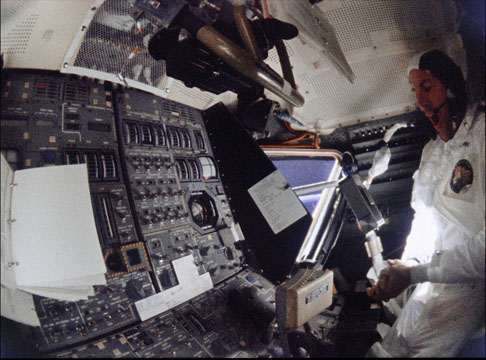
Lovell captured on 16mm DAC film in the LM. Via JSC.
085:51:38 Lousma: Well, what we were really thinking about doing was letting you sleep a little bit longer because we figure you're pretty worn out. [Pause.]
085:51:55 Lovell: Well, I'll go back and forth once in a while to get a [garble]
085:52:01 Lousma: Is Jack up there with you?
085:52:08 Lovell: No, Jack's still sacked out. [Long pause.]
085:52:41 Lousma: Okay, Jim. We're kind of watching this PTC a little bit. Fred's been giving us a few LPD angles as we swang by the center of the Earth - center of the Moon. We noticed that the comm has been degrading just a little bit so you might have to talk up. [Pause.]
085:53:09 Lovell: Roger. Understand.
085:53:11 Lousma: And we just went on to the secondary CO
2 canister. Fred swapped out the primary, but we want to stay on the secondary until it is all used up. [Pause.]
085:53:30 Lovell: Okay. I'm going to use the tape [garble] partial pressure CO
2.
085:53:42 Lousma: We're reading a partial pressure CO
2 of 4.2 millimeters. We're cleared to use the secondary until it reaches 15.
085:53:57 Lovell: Okay. That's good.
This is Apollo Control at 85 hours 56 minutes. About 5 minutes - we'll standby for a call from the spacecraft.
This is Apollo Control at about 85 hours 51 minutes we received a call from the spacecraft. Jim Lovell reported that he was now taking the watch duties while Fred Haise attempted to get some sleep. Jack Swigert apparently still resting in the Command Module. Lovell reported that it had gotten a bit chilly in the Command Module. At the present time Apollo 13 is 197,899 nautical miles from Earth and travelling at a speed of 3,740 feet per second, with respect to Earth.
086:01:47 Lousma: Aquarius, in comparing our initial estimates of water usage and electrical power usage, it appears that we're right on the money on water usage, and we're using a little less amperes than we had originally expected in our first analysis, so we're either right on the money or just a little bit ahead of the game in that regard.
086:02:18 Lovell: Well, that sounds encouraging, Jack.
086:02:24 Lousma: And there are a few temperatures that we're watching for you. You have the heaters powered down. We're looking at them, and those include the PIPAs, the ASA, the quad temps, and your propellants, except for the DPS propellant.
086:02:49 Lovell: Okay. I've got them here. [Pause.]
086:03:02 Lousma: We have, as you probably know, several groups working on procedures from here on out. We have a group working on midcourse corrections to determine a system, the attitudes, how to do it, alignment techniques, and so forth. We have a group working on the entry, including how and when we're going to activate the CSM. We have a group working on the CSM system status, and in a few hours - Later on tomorrow, from where we see it, we're going to go to some base configuration on the CSM and we're going to conduct a MAIN BUS B check. Right now the comm is kind of degrading, and I can't hear what you're about to say very well. But I just want to keep you advised as to how things are going here. And remember you've got duty on the antennas. [Long pause.]
086:05:00 Lousma: Aquarius, are you reading Houston?
086:05:04 Lovell: [Garbled]
086:05:10 Lousma: Okay, Jim. I can hear you talking but I can't tell what you're saying because you're way down in the background noise.
086:05:20 Lovell: Okay. Can you hear Aquarius now? Over.
086:05:23 Lousma: Oh, yes. That's much better. Did you get my report on the various types of people and what they're doing around here?
086:05:30 Lovell: Roger. Sounds like you had things well organized. You might also consider what kind of a stowage configuration [garble] and what we can leave behind in Aquarius. [Long pause.]
086:05:50 Lousma: Okay, Jim. I didn't catch that suggestion on account of the background noise; may be we can pass it on when it gets more favorable.
086:06:07 Lovell: I'm thinking in terms of stowage. Whether we would leave the suit, [garble] the Hycon camera in Aquarius, prior to [garble] [Pause.]
086:06:26 Lousma: Okay. I heard you say something about using the Hycon camera in Aquarius.
086:06:36 Lovell: Negative, Jack. I'm thinking of reentry stowage attitude. Whether we should - what we should leave behind in Aquarius. Leave the suits behind; leaving such big items as the Hycon cameras in Aquarius. Over.
086:06:53 Lousma: Oh, understand. You're thinking about stowage. What'll we leave behind in Aquarius when we fall back into Odyssey. Is that right?
086:07:04 Lovell: That's affirmative.
086:07:06 Lousma: Okay. We've people working on that, too. [Long pause.]
086:07:26 Lousma: And we presently are tracking you at 22,500 [nautical] miles [41,670 km] from the Moon, moving out at 4,400 feet a second [1,340 m/s]. [Pause.]
086:07:43 Lovell: Aquarius. Roger.
This is Apollo Control at 86 hours, 9 minutes. Communications continue to be rather noisy due in part to the fact that the Lunar Module has drifted somewhat out of its Passive Thermal Control attitude and we don't have the best angle on the antennas for reception from the Lunar Module. During that last series of conversations with Jim Lovell and CapCom Jack Lousma, advised him of the status of all consumables on the spacecraft. He reported that the consumables were either ahead of the predicted values or at least right on them. Jim Lovell replied, "That is encouraging". Lovell also asks that here on the ground we look at the stowage in the Command Module and Lunar Module, particularly with an eye to what things can be left behind in the Lunar Module when the crew moves back into the Command Module for Earth entry.
086:10:36 Lousma: And, Jim, earlier in the evening, we thought there was a misunderstanding about the amount of potable water you can drink, but we want to advise you that you can drink as much water as you want to. There's 38 pounds in the potable tank, and that's about all you'll need. The doctors suggest you drink as much fruit juices as you want, too.
086:11:02 Lovell: Roger, Jack.
086:13:52 Lousma: Jim, earlier in the evening, Freddo reported some venting out of window number 1 in the Command Module. He also reported a piece of loose metal about 4 inches square, silver, floating by, and one thing we were trying to establish is whether or not this is a new venting or whether this is part of the residual venting of our original problem. Do you have any more words or comments? And one thing he was doing was taking some photographs and we authorized photographs, targets of opportunity, using the lunar-surface camera number 1, and use the setting of 1/250 of a second, and not knowing precisely what f-stop to use, we suggested taking three of each, using settings of f:4, f:5.6, and f:8. Over. [Pause.]
086:14:57 Lovell: Roger, Jack. The venting really seems to [garble] I reported earlier, I also spotted the large piece go by and prior to our [garble] burn [garble] The venting you see now is much greater [garble] went into the dark mode, you could easily distinguish stars and didn't have the bright articles and bright objects, and I also have the camera here to take photographs [Garbled]
086:16:09 Lousma: Okay, Jim. Once again I hear you talking back there but I can only pick out a few words; maybe we'll have a better time. [Long pause.]
086:16:54 Lousma: Aquarius, we're trying to improve our communications. Could you turn the BIOMED off and give us a voice check, please? [Pause.]
086:17:09 Lovell: Voice check follows: 1, 2, 3, 4, 5, 5, 4, 3, 2, 1; voice check out.
086:17:18 Lousma: Okay, Jim. That seemed to be better.
086:31:02 Lousma: How are you doing there, Aquarius?
086:31:08 Lovell: We're doing good, Jack.
086:31:10 Lousma: Okay. Sometime when you get two guys available there and you could construct one of these lithium hydroxide rigs, I'd like to have you get the materials together, and we'll go through the steps together.
086:31:28 Lovell: Okay. Sounds good. And how do you read me now?
086:31:33 Lousma: Well, there is a lot of background noise, and sometimes it is worse than others and right now I hear you better than I have in the past.
086:31:45 Lovell: Okay, Jack. I'm kind of curious the amount of perturbations our PTC attitude is taking. I notice that we are getting off attitude, and I'm just kind of curious how far we can let this go. [Pause.]
086:32:03 Lousma: We were tracking the attitudes with Fred earlier and it looked like what we were doing was oscillating about some point, but coming back. Are you detecting some kind of divergence now?
086:32:21 Lovell: Not too much. I notice that it's different than when I went to sleep. We are more at an angle now with the terminator of the Earth, so when we started out, we were just about parallel with the terminator, and now we are canted off somewhat. I haven't seen any trends, though, of going back and forth. [Long pause.]
086:33:08 Lousma: And, Jim, our current plan is to not correct the PTC. We're going to take whatever we get and live with it. And we can kind of keep track of what's going on a little better if when you swing past the Earth and swing past the center of the Moon, if you could read off the LPD angles for the center of the Earth and the center of the Moon. Over. [Pause.]
086:33:34 Lovell: Roger. Will do, Jack. And I'm looking into the AOT now to the right - No, the number 4 detent, and we are venting something back there; I can see particles moving on past the Command Module. What it is, I don't know.
086:33:59 Lousma: Okay. Can you identify the quadrant? [Long pause.]
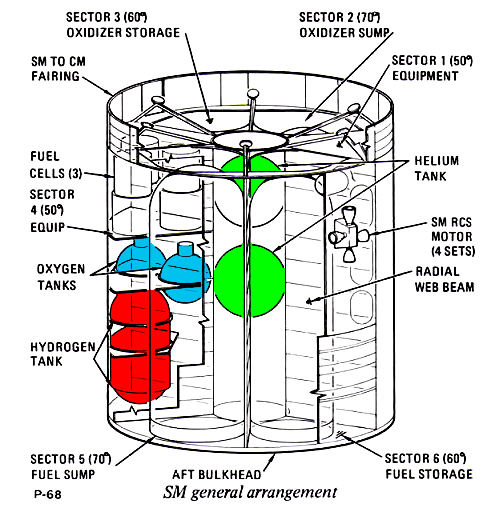
Service Module diagram
086:34:18 Lovell: Well, I'm looking through the right rear reticle now of the AOT, and when I was back in the Command Module, I could see it out of the CM 1 window. The particles are rather small, but they are coming out with some force. That's probably what is disturbing our PTC attitude.
086:34:50 Lousma: Yes, that sounds quite probable, Jim. That's about the same report we got from Fred, but we haven't been able to identify what they might be and probably won't be able to until we crank up the CSM. If there's any change in that status, why, we just want to keep advised of it.
086:35:11 Lovell: Roger. Understand. [Long pause.]
This is Apollo Control at 86 hours 35 minutes. That conversation was a bit difficult to copy entirely. Lovell reported that he had noticed some small particles coming out of the Command Module, apparently coming out of the Command Module, er, Service Module, to be more specific. He said he did not know what the particles were, but that they were small and coming out with some force, and he suggested that this venting was probably disturbing the PTC attitude of the spacecraft.
086:36:09 Lousma: And, Aquarius, we are setting a pretty good vector on you now. And it looks like you're a little bit outside of the corridor. We're looking at a 7 foot per second midcourse at 104 hours. We are going to come up with an Entry Interface minus 8 pad to use in the event of a loss of comm situation [Pause.]
086:36:39 Lovell: Roger. Understand, and I hope you have that procedure for attitude.
086:36:48 Lousma: We are ginning up a procedure for attitude for you, Jim. For the no-comm case, it may be a little different than what the guys working on the procedures come up with for the burn at 104 hours.
086:37:09 Lovell: Roger. [Long pause.]
086:37:36 Lousma: What I'm saying, Jim, is the guys who are working on this attitude situation for the burns haven't made their final conclusions yet, but in the interim period, we want to come up with something you can use, in the event that you lose comm.
086:37:53 Lovell: I concur.
086:40:54 Lovell: Houston, Aquarius. The Earth is going through the 10-degree line or angle of the LPD.
086:41:02 Lousma: Okay, We copied 10 degrees. Is that Earth or Moon, Jim?
086:41:08 Lovell: That is Earth.
086:41:10 Lousma: Okay. Earth 10 degrees. Thank you.
086:45:53 Lovell: And, Houston [garble] As we [garble] No! [garble] has an angle of about 24 degrees on the LPD.
086:46:03 Lousma: Okay. We read 24, Jim.
086:46:09 Lovell: That's affirm.
Jim Lovell continuing to report the relative positions of the Earth and the Moon as they rotate by his LM window. He is comparing the position with a grid marked on the Lunar Module window, the landing point designator, which is a calibrated grid, and by noting the shift in the position of both the Earth and the Moon as the spacecraft rotates we're able to get at least a rough idea of how much the spacecraft attitude is deviating from the original passive thermal control attitude. Now the combined CSM/LM stack is rotating at a rate of about one revolution every 11 minutes at this time. Repeating again, both Lovell and Fred Haise have reported seeing particles coming from the area of the Service Module, apparently venting. Fred Haise was asked at the time he reported it if he felt it was continued venting from the original event which lost the power and oxygen from the Service Module or a new event, and he did not know. A short while ago Jim Lovell reported seeing a similar phenomena. He described it as small particles coming out of the spacecraft from what appeared to be the Service Module. He said that they were coming out with some force and mentioned that this was probably disturbing the passive thermal control attitude. We're watching this with some interest in Mission Control, but with no concern at this point. The primary concern, as I mentioned, is with what effect it would have on the passive thermal control attitude. However, this is not a significant problem. The effect on the passive thermal control attitude is relatively small. The flight dynamics officer has also reported that there is relatively little effect on the position of the vehicle as reflected in the ground tracking of the spacecraft, which would lead us to believe that the venting is relatively small.
086:53:46 Lovell: Jack, [garble] the LPD on the Moon now is 22 degrees.
086:53:51 Lousma: Okay. I'm reading you better, Jim. Say again, please.
086:53:57 Lovell: Roger. The LPD now on the Moon is 22 degrees. I missed the Earth last time. I'll get it this time.
086:54:04 Lousma: Okay. Twenty-two degrees, and looks like we've come up with a procedure for the attitude control on the upcoming burns. Probably the ones that we'll use from here on out. [Pause.]
086:54:23 Lovell: Okay, Jack. Stand by 1.
086:54:30 Lousma: It's going to be a few minutes before I'm ready to read it up to you.
086:59:23 Lovell: Jack, on the Earth of the LPD angles is about a minus 2 degrees and just slightly above the top line.
086:59:36 Lousma: Okay. Just went by minus 2 degrees. Is that on the Earth?
086:59:43 Lovell: That's the Earth. Now, I don't know whether we're oscillating back and forth or not, Jack, or whether it's a continual motion. We'll have to see here.
087:02:35 Lovell: Okay, Jack. The Moon now has an LPD angle of 10 degrees.
087:03:01 Lousma: Roger. The Moon at 10 degrees.
087:04:24 Lousma: Okay, Jim. Just as kind of a lead-in to this procedure that we're going to use for the midcourse burn, I'd like to say that we're going to use AGS and it's going to be a manual burn. The attitude will be controlled manually; the start/stop on the engine will be controlled manually. So we have a pretty good vector on you now, and it turns out you're coming in a little bit too shallow. So what that means is we're going to make our burn to come in a little more steeply, and we're going to be coming in around the dark side of the Earth. Therefore, to come in more steep, our thrust should be in the direction of the Sun. Does that all make sense to you?
087:05:29 Lovell: I think so. We're going to use AGS for a burn monitor. The burns are going to be manual, and they're going to be started manually and stopped manually.
087:05:40 Lousma: Okay. And your reentry is around the dark side of the Earth, and since we're coming in shallow, we're going to have to burn toward the Sun to make it steeper. Do you follow that?
087:06:05 Lovell: That's affirm. Especially these burns will be perpendicular to our flight path and to the Sun giving a steeper entry angle. [Long pause.]
087:06:28 Lousma: Okay, Jim. I heard you say perpendicular to your flight path, which is affirmative, and I didn't get the rest of your statement. [Pause.]
087:06:46 Lovell: I understand the technique, Jack. We're burning to the Sun to steepen our entry angle, and it will be perpendicular to our flight path for corridor control.
087:07:01 Lousma: Okay. That's affirmative. So, in general terms, what we're going to have to do is to power up the AGS and bring up the AGS eight-ball, and then to set up your attitude, put the COAS in the front window, and guidance control will be in AGS, of course. But manually orient the spacecraft to place the center of the Earth directly out the Z-axis. Then rotate about the Z-axis to place the point of the crescent on the Y-axis of the COAS. And this will have your plus X-axis in the direction of the Sun as we discussed before. So the crescent will be up with the point down. Copy that? [Pause.]
087:08:19 Lovell: Okay, Jack. We'll have to go over that again. The COAS will be out front window; we'll place the Earth in the center of the COAS, and, let's see, the center of the Earth right now is parallel to the LPD which is about parallel to our X-axis. And we'll have to rotate about 90 degrees to get our X-axis pointing toward the Sun. [Long pause.]
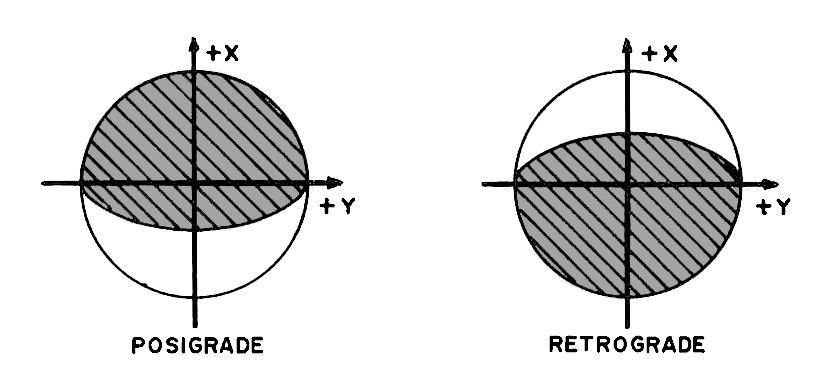
This scan from the Flight Operations Report shows the imagined view of the Earth as it would be seen through the COAS for the alignment for the MCC-7 burn.
087:09:14 Lousma: Okay, Jim. So we want to get the Y-axis of the spacecraft parallel to the terminator by putting the points of the crescent on the Y-axis.
087:09:35 Lovell: Roger. Understand. [Long pause.]
087:09:57 Lovell: Seriously, Jack, when I stop the spacecraft looking at - at the Earth, I'm going to have to roll - in LM terms, roll the spacecraft 90 degrees to get the tip of the Earth all on the Y-axis. [Long pause.]
087:10:45 Lousma: That's affirmative, Jim. You're going to have to roll 90 degrees to point your plus X-axis at the Sun and put the crescent - the points of the crescent on the Y-axis. The points of the crescent on the Y-axis with the COAS pointed at the center of the Earth will take care of your yaw and your pitch. [Pause.]
087:11:16 Lovell: Roger. [Long pause.]
087:11:38 Lousma: Okay, Jim. After you get that orientation to come in a little more steeply, we perform an AGS body-axis align which is at 400 plus 5 on the DEDA. If the AGS ball is up at this time, the AGS ball will go to 000. We can talk more about control modes later, but we'd recommend doing this, of course, in AGS Attitude Hold - Attitude Hold. Put your Yaw to Mode Control and leave Pitch and Roll in Pulse, therefore, controlling your attitude with the TTCA. We don't want to use the gimbal, so have Engine Gimbal, Off. We'll make these burns at 10-percent thrust. We'll use a manual start and stop. For ullage, we'll use the Plus-X Translational button, and ullage will be for 10 seconds. Over. [Pause.]
087:13:06 Lovell: Okay. I understand what you're saying, but you'll have to repeat it here.
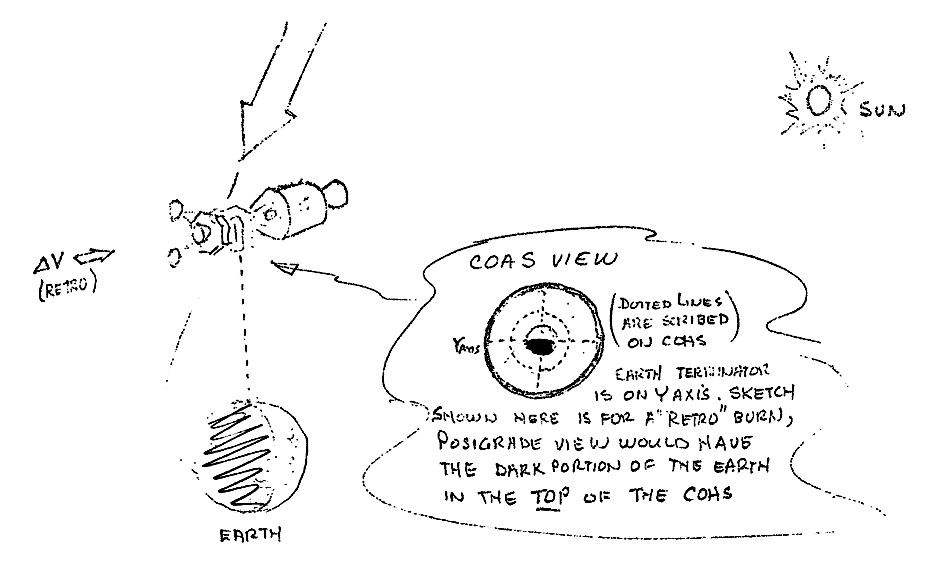
Drawing of the MCC-7 maneuver from the Flight Director's Log. Author unknown.
087:13:15 Lousma: Okay. We'll perform the burn in Guidance Control to AGS. And Mode Control to Attitude Hold. Your Attitude Control switches will be Roll to Pulse, Pitch to Pulse, and Yaw to Mode Control. So the AGS will control your yaw and you will use the TTCA to control pitch and roll. Engine Gimbal Off; 10-percent thrust. Start and stop manual. For ullage, use the plus-X translational button; 10 seconds ullage. Over. [Long pause.]
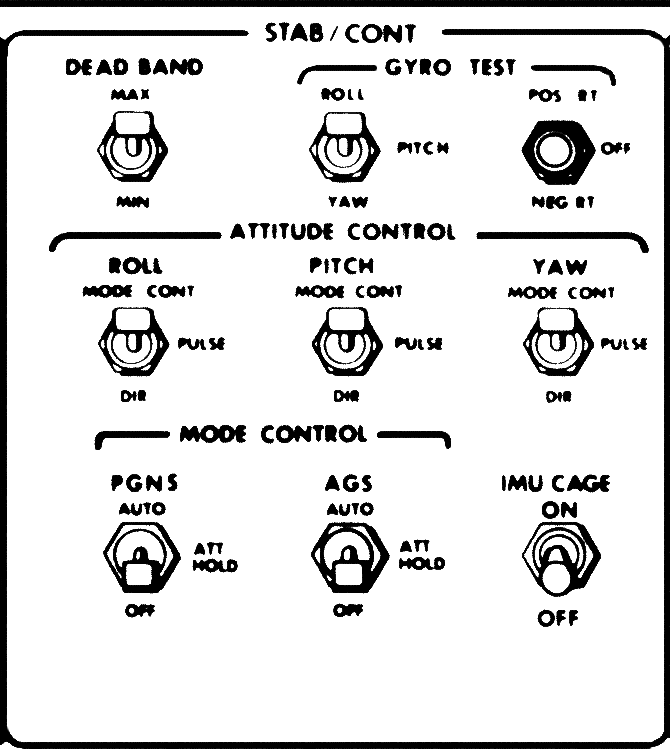
Original scan via heroicrelics.org
087:14:45 Lovell: Okay. For the burn there will be go to Guidance Control AGS, Mode Control Att Hold, Attitude Control switches will be Roll Pulse, Pitch Pulse, Yaw Mode Control. We'll use TTCA control for pitch and roll. Engine Gimbal will be Off; we'll be using 10-percent thrust; we'll start and stop manually, the [garble] ten seconds ullage will be a Plus-X Translational button. And also our thrust will still be, but before that we are going to do an AGS align [garble] ball [Garbled]
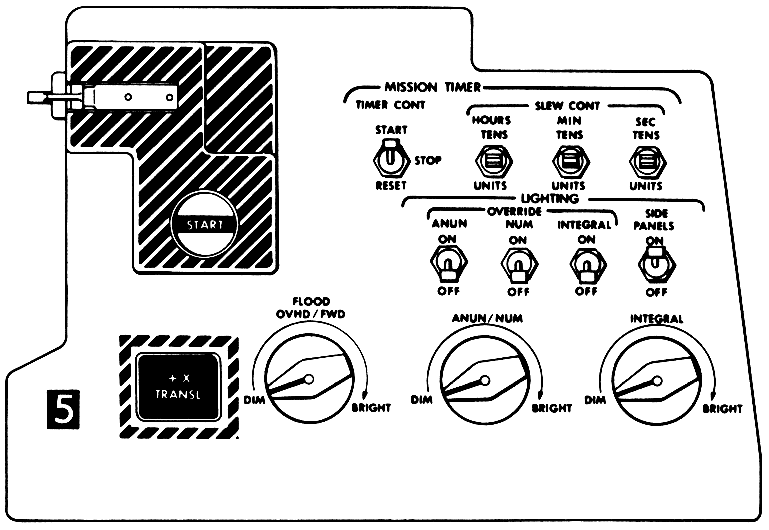
Original scan via heroicrelics.org
087:15:26 Lousma: That's affirmative, Jim. After you get oriented in the attitude you want to burn in, do an AGS align which is - an AGS body-axis align which is 400 plus 5. When you get Enter, this will bring ball up to 000, and I want to confirm that you - that you said Engine Gimbal, Off. O-F-F. Over.
087:15:52 Lovell: Roger. Confirm that Engine Gimbal will be off. [Long pause.]
087:16:11 Lovell: And, Jack, how long do you estimate the length of the burns will be?
087:16:17 Lousma: Okay. The length of the burns are going to be probably less than a minute. And we want you to have cut-off based on time. So we will give you a burn time. And I have a P30 maneuver pad for midcourse-7 in the event that we lose comm if you are ready to copy. [Long pause.]
087:16:56 Lovell: Okay, Jack. Ready to copy. [Pause.]
087:17:06 Lousma: Okay, Jim. P30 LM maneuver pad: the purpose is midcourse-7. Noun 33 is 134:59:42.98. Noun 81 is N/A. H
A is N/A. H
P is plus 0020.5. Delta-V
R is 0019.3. Burn time, 0:39; 008, 000; the rest is N/A; thrust will be at 10 percent. Read back. [Pause.]
087:18:19 Lovell: All right. This is midcourse-7 corridor control, and it's in case we lose comm: 134:59:42.98; Noun 81 is N/A; 42, N/A; plus 0020.5; 0019.3. Burn time, 0:39; 008, 000. All the rest is N/A: thrust 10 percent.
087:19:04 Lousma: Okay, Jim. That's a good readback, and in the event of lost comm, use the procedures that I gave you. It may be that between now and tomorrow these procedures will change a little bit, so we'll go with what we've got now, and stand by for something better if it comes. Over.
087:19:28 Lovell: Okay, Jack. I'm looking at your burn pad and I see that the [garble] total gimbal [garble] 19.3 feet per second. [Pause.]
087:19:44 Lousma: Okay, Jim. We verify 19.3 feet per second for 39 seconds.
087:20:51 Lovell: The old midcourse technique sounds like something that we came up with on Apollo 8.
087:21:00 Lousma: Yes, everybody wondered if you would remember that; by golly, you did. [Long pause.]
087:21:17 Lousma: Hey, Jim, I got a little bit more information - maneuver PAD, I got LAT/LONG range to go, Verb 10 and GET; if you got a place to copy that down, I'll give it to you for EMS. [Pause.]
087:21:38 Lovell: Okay. Stand by. [Long pause.]
087:22:12 Lovell: Go ahead.
087:22:17 Lousma: Okay, Jim. I just have the last three blocks. Noun 61: latitude, minus 021.62; longitude, minus 165.37; range to go, 1162.9; Verb 10:36291: GET of .05g is 142:41:30; read back. [Pause.]
087:22:59 Lovell: I didn't get the latitude, but the longitude is minus 165.67; range to go, 11629; velocity 36291; 142:41:30. [Pause.]
087:23:24 Lousma: Okay, Jim. The latitude is minus 021.62; I have a correction on the longitude - minus 165.37. Go ahead. [Pause.]
087:23:46 Lovell: Roger, Jack. The latitude is minus 21.62; longitude is minus 165.37, and this goes in conjunction with that midcourse 7 pad you gave us.
087:24:02 Lousma: That's affirmative. That means no maneuvers between now and midcourse 7. And this is a horizontal in-plane burn, plus X, toward the Sun, 19.3 feet per second. [Long pause.]
087:24:52 Lovell: Roger, understand.
087:26:31 Lousma: And, Jim, on the - Setting up the AGS, right after you do the 400 plus 5, you should do a 400 plus all balls. And one other point we want to clarify is that we know that you're sure that this burn will be made with the plus X-axis pointing at the Sun to make the entry angle steeper. You got it?
087:27:10 Lovell: That's right, Jack. What I'm going to do is - We'll stop with the Earth in the commander's window, the COAS down, and then I'm going to maneuver the spacecraft so that I have the lighted portion of the Earth at the top of the window; that is, the COAS will be along the plus-Y of the spacecraft and the top of the window - of the rendezvous window, I should be looking into the Sun. That means I'll be burning towards the Sun and steepening the angle. [Pause.]
087:28:03 Lousma: That's affirm, Jim. I - You got the attitude right, and did you copy about doing a 400 plus all balls after - you do the 400 plus 5? That is, a 400 plus 5 and a 400 plus all zeros back to back.
087:28:22 Lovell: Roger. I have copied that.
This is Apollo Control at 87 hours 29 minutes. The conversation which we just had with Jim Lovell related to a - what is called a PAD data for Entry Interface minus 8 hours. This is a more or less routine bit of information which is passed to the spacecraft at various portions of the mission the purpose of which is to give them the information they would need to perform a critical maneuver were they out of communications with Mission Control for any reason. In this particular case, this would be the burn that would put them in the proper position for reentry, if at some point, prior to entry, they had lost communications with Mission Control. Normally, of course, the final midcourse corrections will be made with the information passed from the ground including the spacecraft attitudes. Without communications to the spacecraft, it would be necessary for them to determine their own attitude.
087:30:15 Lovell: Jack - this is Aquarius. I'm not too sure how long or with what force the venting is going to do to our trajectory. However, you might keep a check on that. It may have been going on for some time. [Pause.]
087:30:47 Lousma: Roger, Jim. We've been taking a look at it. We haven't been able to detect it on the Doppler, however.
087:30:56 Lovell: Roger. [Pause.]
Lovell's question there pertained to the ...
087:31:08 Lousma: But we think it's pretty small.
Lovell's question pertained to the venting, which he reported a short while ago. He was asking if the vent was having effect on the trajectory and suggesting that we monitor it to determine how significant effect the venting from the Service Module might have on the spacecraft trajectory. As we mentioned before, we've been tracking and Flight Dynamics Officer reported that he could detect no change in the trajectory which could be attributed to a venting to that reason we would suspect that the effect of the particles coming out of the Service Module is minimal and from that we would also conclude that the vent is quite small.
087:34:05 Lovell: And, Houston, Aquarius.
087:34:09 Lousma: Go ahead, Aquarius.
087:34:14 Lovell: Jack, would you give me a time hack on an even GET so I can start my watch.
087:34:24 Lousma: Okay. Coming up on 87 hours and 35 minutes, we will be there in 30 seconds. Set it for 87:35.
087:34:37 Lovell: Just give me a hack at 88 hours.
087:34:43 Lousma: Okay. I'll give you a hack at 88 hours. That'll be another 25 minutes.
087:34:51 Lovell: All right. Thanks.
This is Apollo Control at 87 hours, 36 minutes. The series of numbers passed up to the spacecraft several minutes ago, as we were saying, related to the pad information which the crew would use in the event they were out of communications with Mission Control because of some unforeseen failure, and were not able to receive from the ground the information needed to do a final midcourse correction prior to entry. In this case, Lovell would be required to get the spacecraft in the proper attitude and perform final midcourse correction with numbers supplied previously, and those numbers were just passed up to him. The procedure for putting the spacecraft in the proper attitude would be to use the Sun and the Earth as reference points, and then once the spacecraft was in the proper attitude he would perform the maneuver as indicated on the Entry Interface minus 8-hour pad, which we just read up to him. This of course, would be a back-up procedure. The normal procedure would be to use the onboard guidance equipment and numbers supplied prior to the burn from the ground, and only in the event of some unforeseen communications failure would this backup procedure be used. At the present time Apollo 13 is 194,269 nautical miles from the Earth and traveling at a velocity of 3,771 feet per second. Coming up at 90 hours, 24 minutes, and 40 seconds, the spacecraft will cross into what is known as the Earth's sphere of influence. At this point in Mission Control we'll begin calculating the spacecraft altitudes and velocities for trajectory purposes with respect to the Earth rather than with respect to the Moon, and we'll also at that point begin to see the velocity climb as a result of the ever increasing of Earth gravity. On the spacecraft, up until that point, the trajectory displays would indicate the spacecraft slowing down under the dominant effect of the lunar gravity. The height from the Earth at the point of sphere crossing would be 188,067 nautical miles, and the distance from the Moon at that time would be 33,821 nautical miles. One other bit of information from the Flight Dynamics Officer is that the midpoint in terms of distance will occur at 119 hours, 44 minutes, 33 seconds; at that point the spacecraft will be 110,730 nautical miles from Earth, and from the Moon. At 87 hours, 39 minutes; this is Mission Control, Houston.
087:41:53 Lovell: Houston, Aquarius.
087:41:56 Lousma: Go ahead, Aquarius.
087:42:00 Lovell: Okay, Jack. Let's just talk over how I'm going to get to the attitude and then do the burn. What I'm talking about is the control techniques. The way it looks now I'll try to stop the spacecraft in yaw with the Earth out my window. Then we'll be in GUIDANCE or we'll be AGS CONTROL; we'll be in - yaw will be in Mode Control. Then we'll be using the TTCAs to control the pitch and then control the roll. I don't see another way we can control the combination that we have here without using the TTCAs. Then we will also use the TTCA during engine burn. Do you people concur with that technique? [Pause.]
087:43:05 Lousma: Jim, that sounds like the one that is best to use to me. Let me talk it over with the rest of the guys here, and we'll advise you.
087:46:43 Lousma: Jim, in that control mode, that sounds like the best way to go. The only thing you'll have to do is to get Attitude Hold in the AGS, and so before you start to maneuver, you'll have to bring the AGS up, and get a 400 plus all zeros in there, and then AGS will respond in yaw when you go to Mode Control. That is, AGS will control your yaw in Mode Control and your pitch and roll can be taken care of in Pulse with a TTCA. After you get in attitude, then, you'll have to re-do an AGS body axis align which is 400 plus 5, then go back to 400 plus all zeros again.
087:47:36 Lovell: Right, Jack. That was my next question. I don't want to align the AGS ball 000 until I am in position, so we use that as a primary attitude burn monitor device. [Long pause.]
087:48:05 Lousma: And, Jim, you can do a 400 plus all zeros any time you want to; that just tells the AGS that you want it to control your attitude should you go to Attitude Hold in Mode Control.
087:48:19 Lovell: Roger. I understand, but after we get to the attitude, we'll do a 400 plus 5 to get the AGS align ball, and then we'll do a 400 plus zero.
087:48:31 Lousma: Affirmative. [Long pause.]
087:49:14 Lousma: Another thing, Jim, is while you're maneuvering to that attitude using AGS to control your yaw, if you find out
en route to that attitude that you didn't quite have the yaw where you wanted it to be, you can use your ACA and tweak up the yaw, and your AGS needles go right back to zero because you zero the attitude errors.
087:49:46 Lovell: Roger. Sounds good.
087:50:48 Lousma: Jim, you'll be splashing down about 560 miles southeast of Samoa at about 0800 local time. The weather forecast for the area is good; 1500, scattered, high broken, 10-mile visibility. The seas will be 5-foot waves, 15 knots, and you'll be going to Samoa by boat and/or aircraft. You'll spend either the night on the boat or in Samoa and return to Ellington by 141 on Saturday, the following day.
087:51:37 Lovell: Roger. Would you tell the people of the LRL to turn it off.
087:51:46 Lousma: Oh, no. We're going to do the whole bit.
087:53:21 Lovell: And don't forget my hack at 88 hours, Jack.
087:53:24 Lousma: Say again, please, Aquarius.
087:53:30 Lovell: I want to get my time hack at 88 hours.
087:53:33 Lousma: Roger. That will be in about 6-1/2 more minutes.
087:56:20 Lousma: Jim, we got a couple of news-type items. President Nixon has chosen a judge from Minnesota for the position of Associate Justice in the Supreme Court. A bill giving federal employees a 6-percent pay raise passed the House and went to the President; includes the military. And the air traffic controllers returned to work.
087:56:57 Lovell: Well, that's great. You think they'll consider this for flight pay? [Long pause.]
087:57:33 Lousma: Well, we might be able to work out some arrangement.
087:58:35 Lovell: Standing by for the 88-hour time hack.
087:58:43 Lousma: Say again, Jim.
087:58:47 Lovell: Standing by for the 88-hour time hack.
087:58:52 Lousma: Okay. We got a minute to go.
087:59:54 Lousma: Okay. Coming up on the 88-hour mark. I'll give, you a 2-second delay. Stand by to mark.
088:00:05 Lovell: I got it.
088:10:10 Lousma: How are you doing, Jim?
088:10:16 Lovell: Pretty good, Jack. Say, you might have the people look at our DPS burn card to see what changes have to be made on it for the burn.
088:10:30 Lousma: Heard you say look at the DPS burn; you'll have to say what about it again, please. [Pause.]
088:10:39 Lovell: Roger, Jack. You might take a look at our DPS burn card, our checklist card that we have in the LM, and see what changes might have to be put in that checklist.
088:10:50 Lousma: Okay, DPS burn card.
Here's some words on that vent that the crew report ...
088:25:18 Lousma: How're you doing there, Jim?
088:25:23 Lovell: Okay, Jack. It appears that we're going - funny diversion here, the PTC attitude in - in pitch. I'm going to do a LPD check now, but the last time the Moon went around, it was above - way away above the LPD angle and I see the Earth coming around now which is going to be pretty low. They oscillate back and forth, but each time they seem to get a little farther away from the center line. You might think of some procedure to reestablish PTC, if it's necessary.
088:27:09 Lousma: Jim, the only way we know of getting the as good or a better PTC than you've got right now is to crank up the G&N and we - We don't want to do that. So our plan is to just take whatever we get out of this, and later on, it may turn out by the time you get to burn attitude, you'll be right where you want to be.
088:27:37 Lovell: Okay. We'll just leave her go.
088:30:36 Lovell: Houston, Aquarius.
088:30:38 Lousma: Go ahead.
088:30:42 Lovell: What's our course of action to set up PTC after this midcourse at 107?
088:30:51 Lousma: We thought you'd ask that. [Long pause.]
088:31:06 Lousma: The only thing we can try to do, Jim, is to set the thing up manually and see what happens. There must be a better answer than that.
088:31:18 Lousma: ...and one course of action is to omit the midcourse and make a total midcourse, say, about 8 hours before entry. We haven't decided yet.
088:31:37 Lousma: Right now we're talking about a 7 foot per second midcourse at 104 hours. And extrapolate that down to about 8 hours before entry. We gave you a pad for that - that's about, only 19 feet per second, so if it doesn't change too much - and we can get all kinds of DPS. [Pause.]
088:32:01 Lovell: Understand. Sure like to keep this vehicle in the corridor though.
088:55:07 Lovell: Houston, Aquarius.
088:55:10 Lousma: Go ahead, Aquarius.
088:55:16 Lovell: Can you think of any normal venting phenomena that might occur like maybe - a hydrogen tank that's over-pressurized relieving in the window?
088:55:31 Lousma: Yes, we thought of that, Jim. [Long pause.]
088:55:52 Lousma: That is one possibility that we have thought of, Jim, because - We heated up that tank, and we haven't been using any hydrogen and, therefore, it could be venting in the overboard relief.
088:56:10 Lovell: Right. The only other thing I can think of when I look at it through the AOT is - it did appear to be coming from one spot, but that's the only difference although I can't see where it is coming from because it's beyond the curvature of the Command Module. But, it appears like it might be coming from more than this one spot.
088:56:34 Lousma: Okay. Thank you. We hope that when we crank up the Command Module tomorrow that we'll be able to - or later on today - that we will be able to identify more closely what it's been coming from. But, the guidance guys say that they haven't been able to see the results of any venting in their data and it would take a very, very small amount to perturb their data.
088:57:02 Lovell: Well, that's a note of encouragement.
088:58:28 Music
088:58:57 Lousma: You got a Chinese band going up there?
088:59:04 Lovell: Oh, sorry. I forgot all about hot mike.
088:59:10 Lousma: Sounds pretty good.
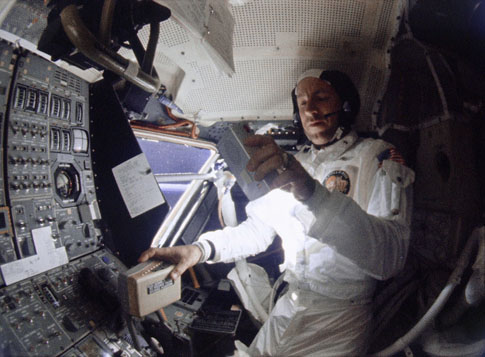
16mm film capture of Lovell in LM. JSC



